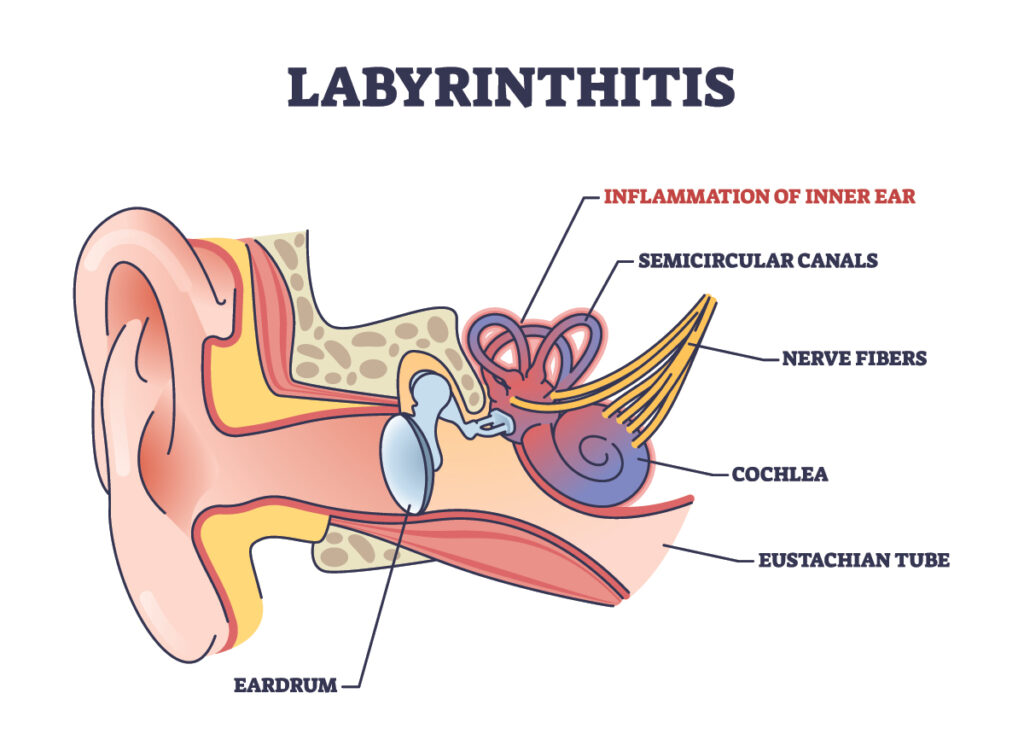Labyrinthitis
An inflammatory disorder of the inner ear which includes the cochlea – responsible for converting sounds into neural impulses for hearing.

Labyrinthitis is an inflammatory disorder of the inner ear. This part of the ear includes the cochlea – responsible for converting sounds into neural impulses for hearing, and the vestibular organs – responsible for balance and spatial orientation.
What Causes Labyrinthitis?
Labyrinthitis is the general term for inflammation of the inner ear. Sometimes the term vestibular neuritis is used interchangeably with labyrinthitis. Although the presentation and symptoms of vestibular neuritis and labyrinthitis are very similar, they are technically not the same condition. Vestibular neuritis specifically refers to inflammation of the vestibular nerve within the labyrinth, while labyrinthitis refers inflammation involving the entire labyrinth (inner ear) structure.
Labyrinthitis can arise from a number of different causes, including:
Viral infection
This is the most common cause of labyrinthitis, typically due to an upper respiratory tract virus such as a cold or flu. Other types of viruses can also lead to labyrinthitis, including infections picked up during pregnancy and passed on to the baby, such as rubella or cytomegalovirus. In most cases, the specific virus responsible for causing viral labyrinthitis remains unidentified.
Bacterial infection
Less commonly, labyrinthitis may have a bacterial cause. This is usually from the spread of bacteria for bacterial meningitis or a middle ear infection. Bacterial labyrinthitis may need to be managed in the hospital and carries a higher risk of permanent hearing loss.
Autoimmune causes
Rarely, labyrinthitis can be part of a systemic autoimmune syndrome such as rheumatoid arthritis, inflammatory bowel disease, or systemic lupus erythematosus. Other autoimmune disorders associated with labyrinthitis include polyarteritis nodosa and granulomatosis.
Trauma
Injury to the inner ear – whether from accidental trauma or surgery – may result in inflammation and labyrinthitis. Examples include skull fractures, concussion, and tumors involving the inner ear, such as an acoustic neuroma.

Though labyrinthitis can occur in anyone at any time, several factors may increase the risk of developing this condition, such as:
- Recent viral infections, including the common cold
- Cholesteatoma
- History of ear surgery
- Meningitis
- Middle ear infection (otitis media)
- Smoking
- Excessive alcohol consumption
- Allergies
- Stress and fatigue
- Certain medications
- Traumatic injury to the skull or inner ear
Labyrinthitis Symptoms
Labyrinthitis isn’t typically marked by pain. Instead, symptoms are focused around issues of hearing and balance, as is characteristic of an inner ear disorder:
- Dizziness and vertigo
- Loss of balance and gait problems
- Tinnitus
- Hearing loss
- Nausea and vomiting
- Nystagmus (an involuntary jerking movement of the eyes)
The most common symptoms of labyrinthitis are nausea, vomiting, and severe vertigo. The vertigo typically resolves within 72 hours, though short episodes may recur over a period of several weeks following the initial event.
Diagnosis and Treatment of Labyrinthitis
The symptoms of labyrinthitis are not unique to inner ear inflammation. By assessing your medical history for risk factors and a physical exam, your doctor can usually differentiate labyrinthitis from other conditions with similar symptoms. If there is concern about an acoustic neuroma or a brain bleed, you may require imaging with an MRI or CT scan.
Note that if your hearing and balance symptoms are also accompanied by other neurological abnormalities such as numbness, weakness or paralysis, facial pain, fainting, convulsions, double vision, or slurred speech, this is not labyrinthitis and must be treated as a medical emergency.
If a diagnosis of viral labyrinthitis is confirmed, the main management strategy is simply bedrest and keeping hydrated. Some doctors may recommend a steroid medication to help manage the inner ear inflammation, but there is currently little evidence to support this. In the case of autoimmune labyrinthitis, corticosteroid medications are recommended, or some other sort of immunomodulatory drug. Bacterial labyrinthitis is treated with antibiotics, an ear tube, or other surgical procedure.
In the meantime, symptoms can be managed with medications, including those for vertigo and nausea. Studies have found that making an effort to get moving as soon as possible helps the vestibular system to recover more quickly, as does avoiding taking anti-vertigo medications for longer than 72 hours.
On occasion, the effects of labyrinthitis can persist even after the inflammation has resolved. Hearing loss, tinnitus, and balance difficulties may need to be managed with a variety of healthcare professionals, such as an audiologist, otolaryngologist (ear, nose, throat surgeon), and vestibular therapist.
